Book contents
- A Qualified Hope
- Comparative Constitutional Law and Policy
- A Qualified Hope
- Copyright page
- Contents
- Notes on Contributors
- Foreword
- Acknowledgments
- Introduction
- Part I The Supreme Court of India – An Institutional Overview
- Part II The Supreme Court of India, Social and Political Mobilization
- 6 The Art of Buying Time
- 7 Court as a Symbolic Resource
- 8 PUCL v. Union of India
- Part III Welfare Rights and the Environment
- Part IV Discrimination
- Conclusion
- References
7 - Court as a Symbolic Resource
Indra Sawhney Case and the Dalit Muslim Mobilization
from Part II - The Supreme Court of India, Social and Political Mobilization
Published online by Cambridge University Press: 19 August 2019
- A Qualified Hope
- Comparative Constitutional Law and Policy
- A Qualified Hope
- Copyright page
- Contents
- Notes on Contributors
- Foreword
- Acknowledgments
- Introduction
- Part I The Supreme Court of India – An Institutional Overview
- Part II The Supreme Court of India, Social and Political Mobilization
- 6 The Art of Buying Time
- 7 Court as a Symbolic Resource
- 8 PUCL v. Union of India
- Part III Welfare Rights and the Environment
- Part IV Discrimination
- Conclusion
- References
Summary
This chapter analyzes the impact of the Indian Supreme Court's watershed case on quotas for "backward classes," the Indra Sawhneycase. It explores the role of the decision in the mobilization of Dalit Muslims, who have been excluded from the constitutionally mandated affirmative action regime for the erstwhile Untouchable or Dalit castes ("Scheduled Castes"). It shows how the incipient mobilization came to creatively interpret the decision, in particular its interpretation of Hindu caste and a partial recognition of Muslim social stratification, as an endorsement of their claims. The appropriation and activation of the judgment allowed the mobilization to generate further political support, convince state commissions and eventually mount a constitutional challenge in the Court. This account aims to highlight the symbolic potential of the Court's decisions, often through unintended mechanisms, to reshape and extend social movement politics. It also highlights the role of political constraints, organizational infrastructure and the Indian institutional context as relevant factors in assessing judicial impact.
Keywords
- Type
- Chapter
- Information
- A Qualified HopeThe Indian Supreme Court and Progressive Social Change, pp. 184 - 211Publisher: Cambridge University PressPrint publication year: 2019
References
- 1
- Cited by

